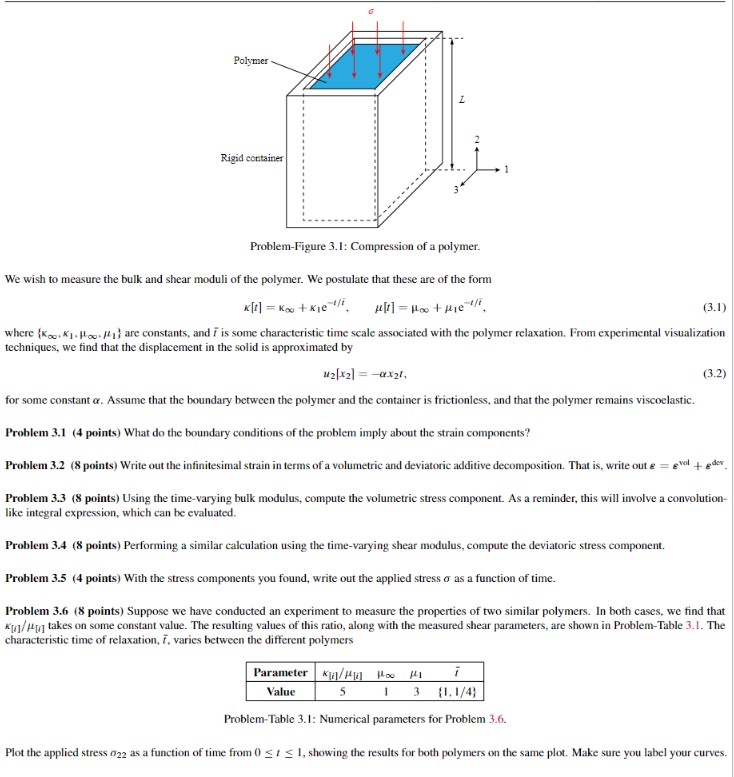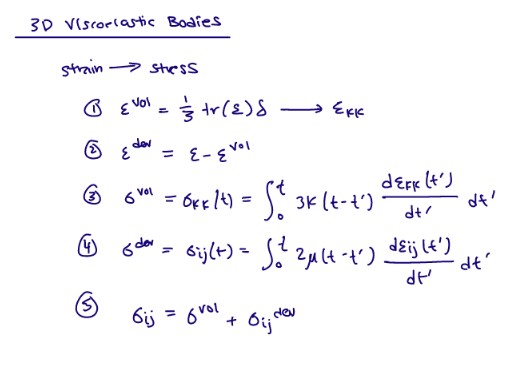Answered step by step
Verified Expert Solution
Question
1 Approved Answer
3 Compression of a Polymer (40 points) A rigid container of height L holds a polymer of unspecified identity in the center. At time



3 Compression of a Polymer (40 points) A rigid container of height L holds a polymer of unspecified identity in the center. At time = 0, a load or is applied on the top of the polymer, causing it to compress down with time; this load is continuously applied, as shown in Problem-Figure 3.1. Polymer Rigid container Problem-Figure 3.1: Compression of a polymer. We wish to measure the bulk and shear moduli of the polymer. We postulate that these are of the form [] = + (3.1) where {K. K1. Hoo. 41} are constants, and 7 is some characteristic time scale associated with the polymer relaxation. From experimental visualization techniques, we find that the displacement in the solid is approximated by u2[x2]=-ax21, for some constant a. Assume that the boundary between the polymer and the container is frictionless, and that the polymer remains viscoelastic. Problem 3.1 (4 points) What do the boundary conditions of the problem imply about the strain components? Problem 3.2 (8 points) Write out the infinitesimal strain in terms of a volumetric and deviatoric additive decomposition. That is, write out vol (3.2) Problem 3.3 (8 points) Using the time-varying bulk modulus, compute the volumetric stress component. As a reminder, this will involve a convolution- like integral expression, which can be evaluated. Problem 3.4 (8 points) Performing a similar calculation using the time-varying shear modulus, compute the deviatoric stress component. Problem 3.5 (4 points) With the stress components you found, write out the applied stress or as a function of time. Problem 3.6 (8 points) Suppose we have conducted an experiment to measure the properties of two similar polymers. In both cases, we find that Ku/takes on some constant value. The resulting values of this ratio, along with the measured shear parameters, are shown in Problem-Table 3.1. The characteristic time of relaxation, 7, varies between the different polymers Parameter Value / 5 i 1 3 (1.1/4} Problem-Table 3.1: Numerical parameters for Problem 3.6. Plot the applied stress 022 as a function of time from 011, showing the results for both polymers on the same plot. Make sure you label your curves. 3D Viscoelastic Bodies Strain Stress = - Ekk dev = -01 6 Vol 6 Val = 6xx/4) = St 3K (+-+'); dFK (t') df' dt' oder = bij(+) = St 2 (t-t') dij (t') 'dt' 6ij = 6 vol + bij dev dt'
Step by Step Solution
There are 3 Steps involved in it
Step: 1

Get Instant Access to Expert-Tailored Solutions
See step-by-step solutions with expert insights and AI powered tools for academic success
Step: 2

Step: 3

Ace Your Homework with AI
Get the answers you need in no time with our AI-driven, step-by-step assistance
Get Started


